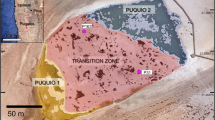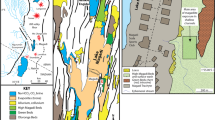Abstract
RECENT sedimentation in Lake Balaton is governed chiefly by two processes1. (a) Clastic material (quartz, feldspars, calcite, dolomite, phyllosilicates, heavy minerals) introduced by wind and rivers is distributed on the bed by the currents. (b) During the warmer seasons much finegrained high-magnesian calcite is precipitated from the lake (average depth, 3.3 m; July average temperature, 25° C) because of the dense and extensive growth of phytoplankton. In photosynthesis CO2 is liberated from dissolved bicarbonate, and carbonate is precipitated.
This is a preview of subscription content, access via your institution
Access options
Subscribe to this journal
Receive 51 print issues and online access
$199.00 per year
only $3.90 per issue
Buy this article
- Purchase on Springer Link
- Instant access to full article PDF
Prices may be subject to local taxes which are calculated during checkout
Similar content being viewed by others
References
Müller, G., Naturwissenschaften, 56, 606 (1969).
Entz, B., Ann. Biol. Tihany, 26, 131 (1959).
Szesztay, K., Intern. Symp. Paleolimnology, 26 (Biological Research Institute, Hungarian Academy of Sciences, Tihany, 1967).
Pásztó, P., Tanulmányok és Kutatási Eredmények, 2 (Budapest, 1963).
Weiden, P., Wiss. Arb. a.d. Burgenlaud, 23, 73 (1959).
Author information
Authors and Affiliations
Rights and permissions
About this article
Cite this article
MÜLLER, G. High-magnesian Calcite and Protodolomite in Lake Balaton (Hungary) Sediments. Nature 226, 749–750 (1970). https://doi.org/10.1038/226749a0
Received:
Issue Date:
DOI: https://doi.org/10.1038/226749a0
This article is cited by
-
Geochemical Proxies and Mineralogical Fingerprints of Sedimentary Processes in a Closed Shallow Lake Basin Since 1850
Aquatic Geochemistry (2022)
-
Heterogeneously nucleated calcite precipitation in Lake Constance. A short time resolution study
Aquatic Sciences (1990)
-
Formation and diagenesis of inorganic Ca?Mg carbonates in the lacustrine environment
Die Naturwissenschaften (1972)
-
Aragonite Inorganic Precipitation in a Freshwater Lake
Nature Physical Science (1971)
Comments
By submitting a comment you agree to abide by our Terms and Community Guidelines. If you find something abusive or that does not comply with our terms or guidelines please flag it as inappropriate.



